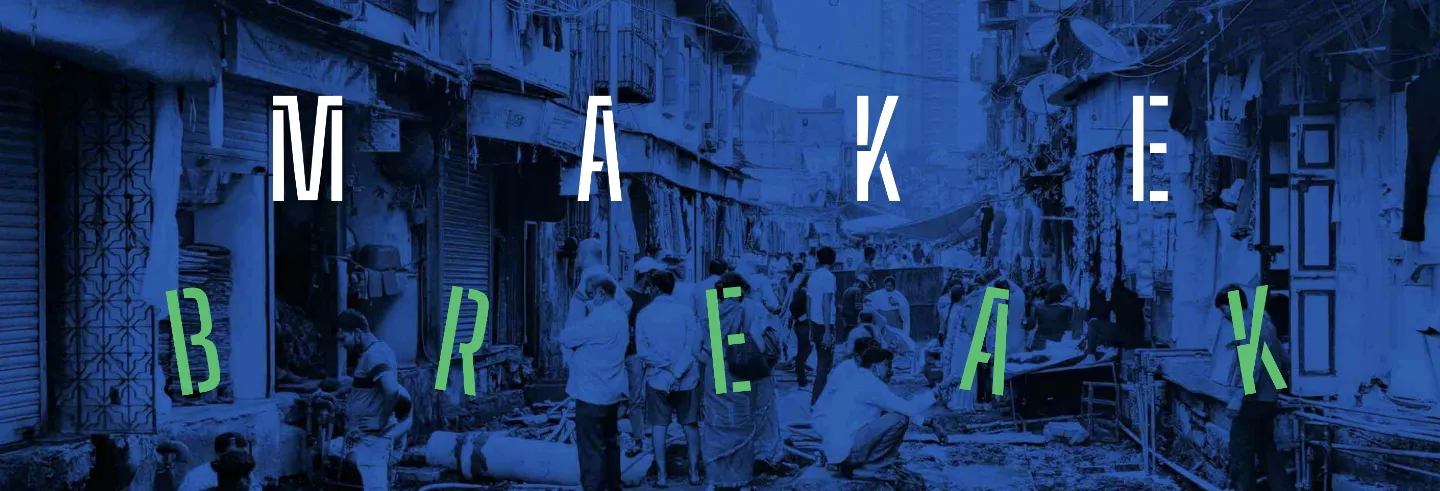By Himanshu Burte, Amita Bhide, Lalitha Kamath, and Ratoola Kundu
Mumbai has been transformed significantly over the last three decades through policy, planning, and governance initiatives that followed the national neoliberal turn.
This was reflected in the withdrawal of several subsidised public goods and services, as well as attempts to attract private investment through a major infrastructural overhaul of the city. These changes have led to a dramatically altered built environment — a rash of tall buildings enabled by redevelopment policy and planning regulations, elevated metro and monorail, new road infrastructure, and the Sea-Link among others. Many in the state, the middle class, and the city’s social elite (including the media), see these as necessary transformations. After all, they give Mumbai a world-class patina while appearing to address acute problems that threaten to overwhelm the city, including through affordable housing and adequate transport infrastructure. However, we need to ask: what have been the benefits and costs of these transformations, who has gained, who has lost, and how have policies, plans and state investments actually worked?
These are important questions because the restructuring of Mumbai has impacted the poor the most and in different ways. It has involved large-scale displacement, sometimes worsening their living conditions or forcing them to undertake nearly impossible adjustments, as in resettlement colonies. Elsewhere, it has impacted livelihoods or intensified the everyday struggles for basic needs. Whatever our ethical and political beliefs, it is clear that the fate of the majority of a city’s population is closely tied to the transformations that the city is undergoing. We need to understand these better, and do so through a more democratic process — the fate of the majority is too important to leave only to planning and policy ‘experts’.
Who has gained, who has lost, and how have policies, plans and state investments actually worked?
In an online exhibition titled Makebreak, we seek to initiate a critical public dialogue on how Mumbai is transforming by focusing on one aspect of this important enquiry: how have different marginalised populations in the city experienced these transformations? How have they responded?
The DNA of Makebreak is the lived knowledge, or the voices and experiences of marginalised groups. These contest the policy assurances that claim that the spatial transformations of the city have and will continue to benefit everyone. The narratives, instead, reveal what displacement, dispossession, precarity, and stigmatisation mean as lived experience. Instead of wider public benefit, they show the widening of different forms of violence that the transformation has brought to poor and marginalised communities.
This is often quiet, even invisible, occurring and building up over decades while also shaping future possibilities of survival in and appropriation of the city by marginalised groups. It is mobilised through dominant social and institutional structures, such as plans and laws that claim to improve lives and futures. (For a historical profile of the structural violence of Mumbai’s spatial history, see Amita Bhide (2013)). Such harm has been termed "structural violence" by Galtung (1969), who sees it as distinct from but related to direct physical violence.
[S]tructurally violent plans and laws have been the mechanism of spatial transformation in Mumbai’s recent history.
The term structural violence is useful because it focuses attention on the hidden violence that legal and legitimate frameworks of collective action can cause. In cities, these include policy initiatives, plans and projects undertaken by state and market actors within the ambit of law. We argue through Makebreak that structurally violent plans and laws have been the mechanism of spatial transformation in Mumbai’s recent history. These have led to a range of processes and outcomes that are violent but vary in the degree to which they can be readily recognised as such. Moreover, structural (or indirect) and direct, physical violence are often connected to each other.
Of course, marginalised people have resisted this range of violences creatively and refashioned ways of living to survive, and even thrive, under difficult situations. Makebreak, thus, illuminates not only the hidden violence and suffering faced by marginalised social groups, but also the richness of life trajectories and everyday life that this violence has interrupted, and the continuing struggle to thwart this violence and secure their own survival and consolidation. What better way to begin to recognise this complex trajectory than through visual stories?
Four stories
Four cases, or stories within stories, make up the exhibition. They speak from diverse locations, conditions, themes and temporalities across Mumbai as the city’s footprint has expanded from the Island City to the metropolitan region. While appearing vastly different at first glance, the caseload of stories is held together by the ways in which they embody different forms of structural violence visited on already vulnerable people. Thinking across cases, we may find striking similarities in the ways in which structural violence plays out in different contexts at different times, and the ingenuity with which marginalised groups attempt to counteract it.
Kamathipura: Countering marginalisation
The first set of stories concerns the historical and continuing marginalisation of the Island City-neighbourhood called Kamathipura, known for long as the red-light area of Mumbai. In reality, Kamathipura reveals a rich and diverse history of the poor, working-class migrants who built it before the colonial government designated it as a red light area. Today, the neighbourhood's marginalised and middle-class groups chafe at being treated as social outcasts by the rest of the city simply because of their address, and at a built environment that is fast deteriorating due to neglect stemming from stigmatisation (Figure 1). Thus, the persistent threat of displacement and dispossession of the poor and working classes from the heart of the city as large-scale redevelopment projects take over the ageing city core, is one specific form of violence that the inner-city presents.
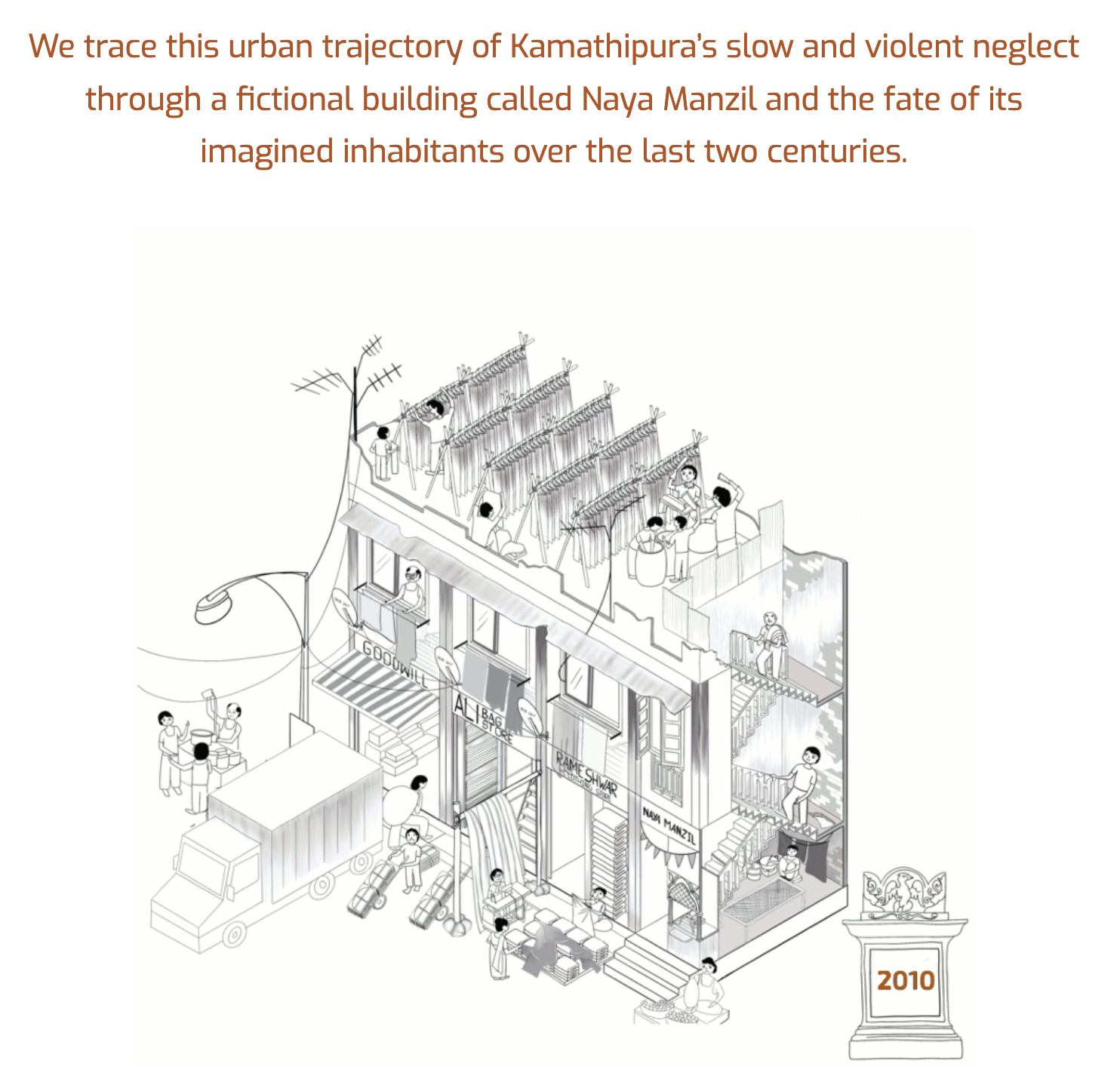
The hidden violence of infrastructural development is foregrounded in the story of 'JVLR' (or, Jogeshwari Vikhroli Link Road). Here, the widening of the eponymous road in the mid- 2000s undoes a decades-old history of informal placemaking thereby ‘maiming’ place. ‘Informal placemaking’ refers to the fact that the ‘slum’ has actually been made as a valued place against great odds over many decades through inspiring processes of community building and leadership. The severance of this informal place — cut in two by the fast road — cannot be seen as the isolated effect of a single road (Figure 2). Rather, it is the city's road network as a whole which JVLR strengthened and which privileges elite lives and economies, that must be seen to have maimed place. Of course, as elsewhere, the community vigorously protested this maiming, asserting a right to place with some success, but also faced new burdens. JVLR thus urges us to rethink the social cost of aspirational infrastructure.
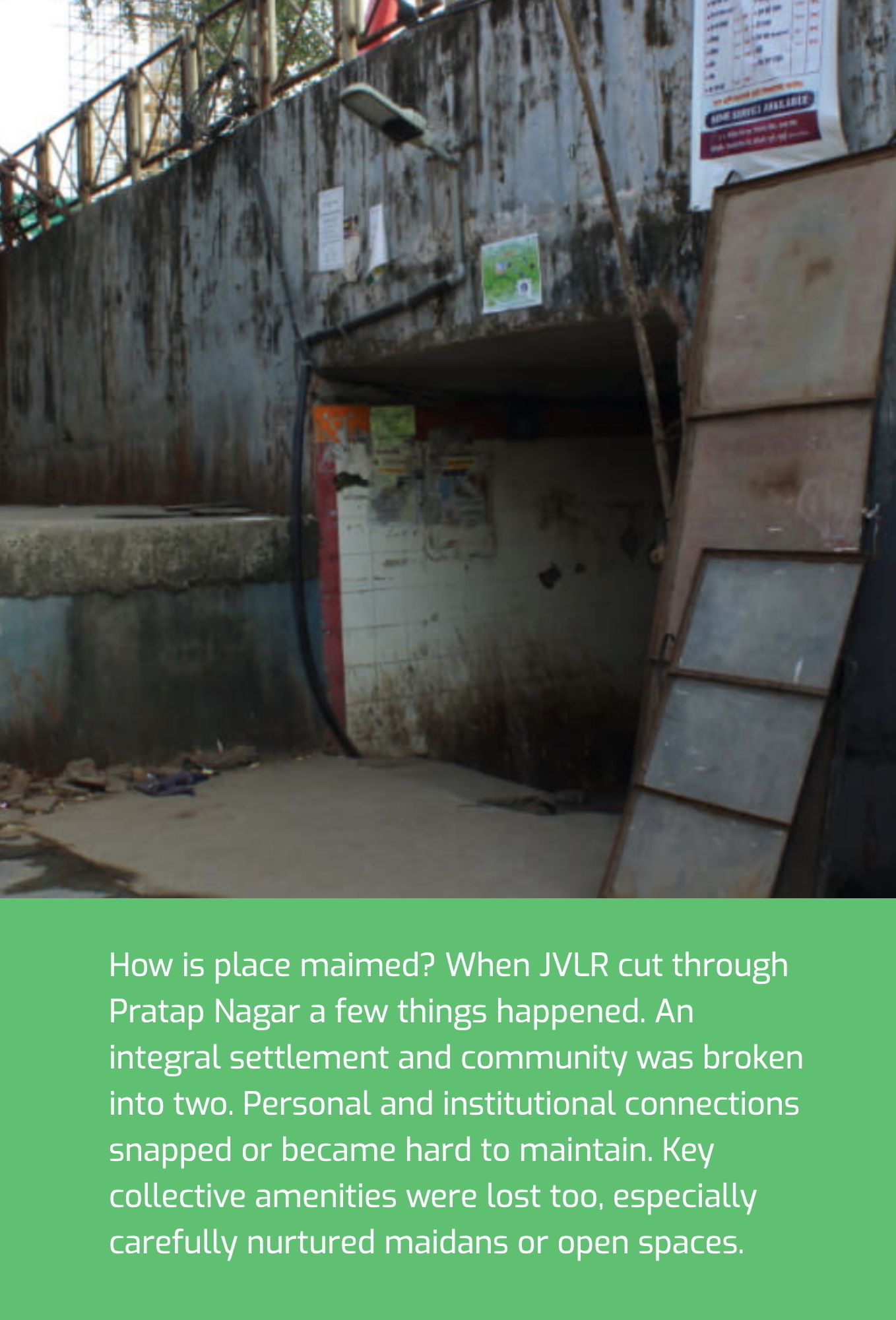
Nala Sopara: periperalised/tadipar
Being pushed out of the city is itself a kind of violence. Thus, 'Peripheralised/Tadipar' focuses on the interconnected processes — displacement , organised abandonment and disposability — by which poor and migrant groups and their modes of habitation are being pushed out of Mumbai’s municipal limits in order to remake a shiny ‘world-class’ Mumbai. Banished 60 km northwards to the violent sociality of Nala Sopara, people act to repair and remake their lives in Mumbai’s vast extended periphery. Through their resourcefulness and labour, the city is being (re)built not just in Mumbai but in Nala Sopara too. The story shows that 'world-class' interventions are intertwined with processes of peripheralisation: to understand Mumbai, we need to understand Nala Sopara.
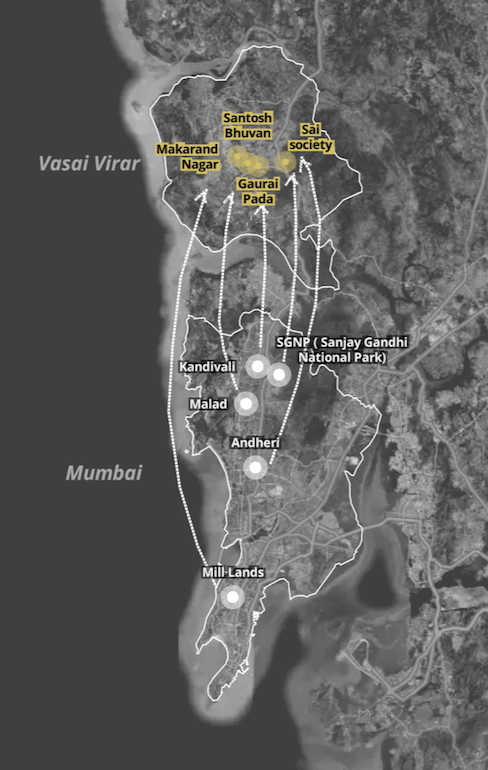
M-Ward: A struggle to make, in the face of peripheralisation
Of course, the violences of peripheralisation occur within city limits too, particularly in the administrative ward of Mumbai called ‘M East’ (Figure 4).
M (East) Ward embodies a more general paradox. On the one hand, it typifies areas within the city that are systematically set aside for ‘dumping’ — waste , hazardous industries, people considered a burden on society such as beggars, women rescued from trafficking, and children in difficult circumstances. On the other hand, these very areas are also made into valued places by subaltern groups. In recent years, this ward has received the maximum inflow of people displaced by infrastructure projects in the city and is emerging as an enlarged ghetto of poor, Dalit and minority populations with few prospects of decent livelihoods and bereft of adequate infrastructure and amenities. M (East) ward in Mumbai thus reflects an ongoing tussle between forces that dump, commoditise, and displace on the one hand, and forces that make the city livable on the other.
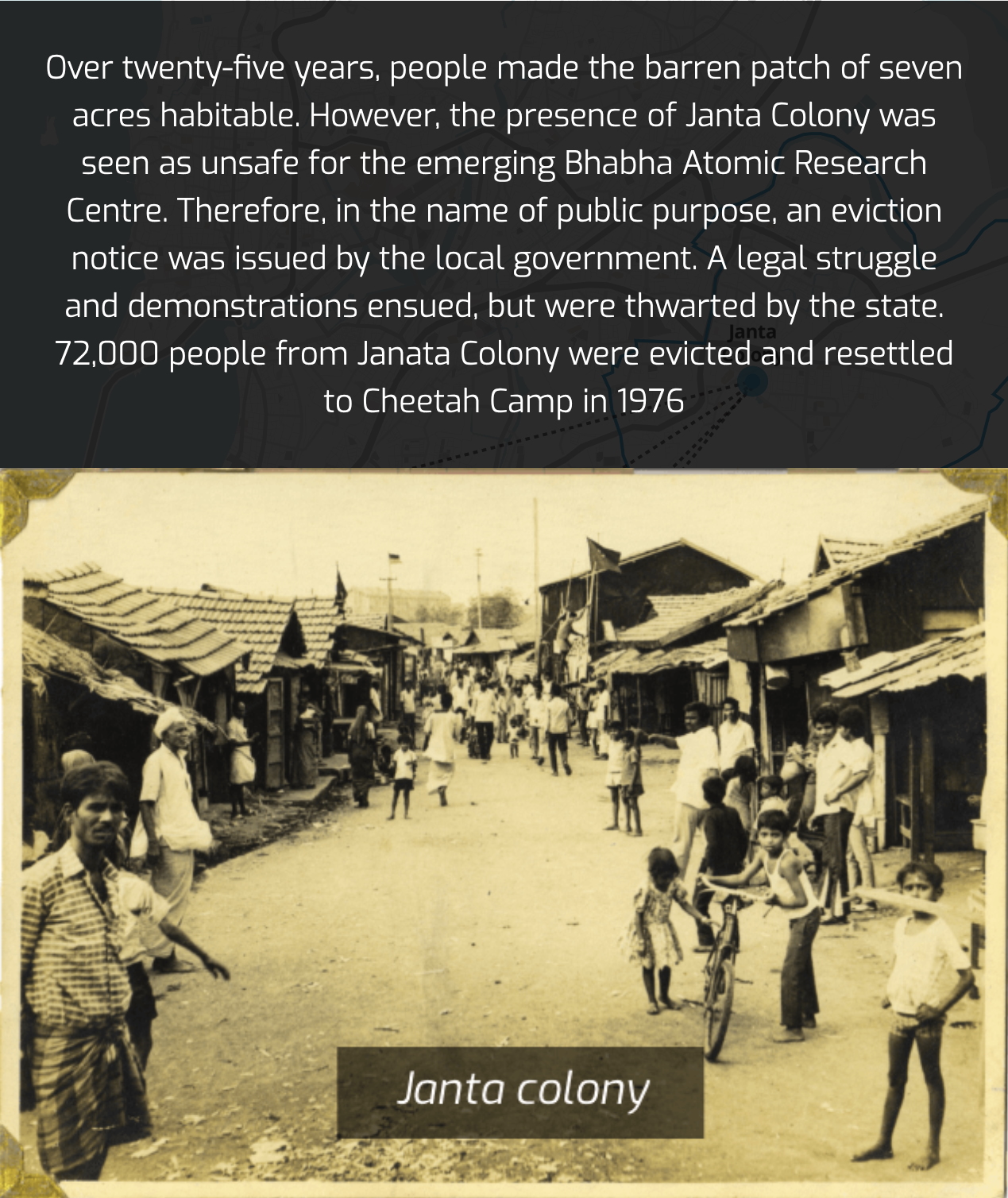
Telling a shared story
No story can be separated from its telling. Since we sought to bring to light the lived violences of spatial transformation, we relied on developing visual-spatial stories and maps. Mapping was central to studying how changes to the physical city transformed people’s lives. It is increasingly a tool communities also use in their own struggles. Mapping helped us to reconstruct unrecorded spatial histories and diverse settlement trajectories and to show how seemingly disparate geographies are connected through flows of people, ideas, goods and policies.
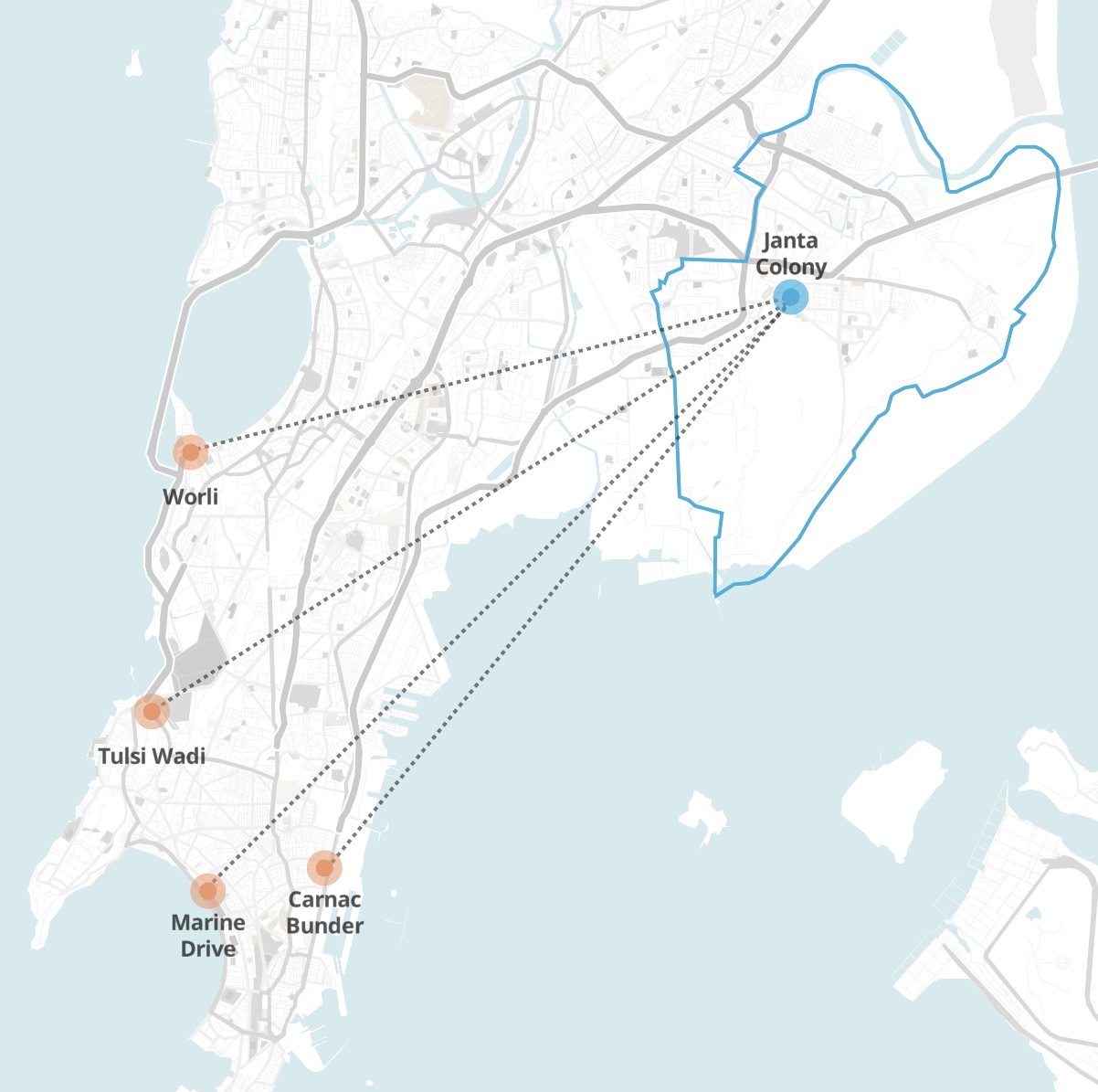
Combining maps with photographs, sketches — and even the occasional gif — led to new visualisations of lived reality that could dignify particular communities, places and mobilisations in public representation. For instance, the archival image of Janta Colony before it was demolished (See Fig 4), or the images of public spaces in Pratap Nagar (See Figure 6) among others in the exhibition, show that informal settlements (and livelihoods) are not lived as the completely abject spaces the elite imagine them to be. They reveal a variety of ways in which people have organised dignity and created meaning in the face of hostile conditions.
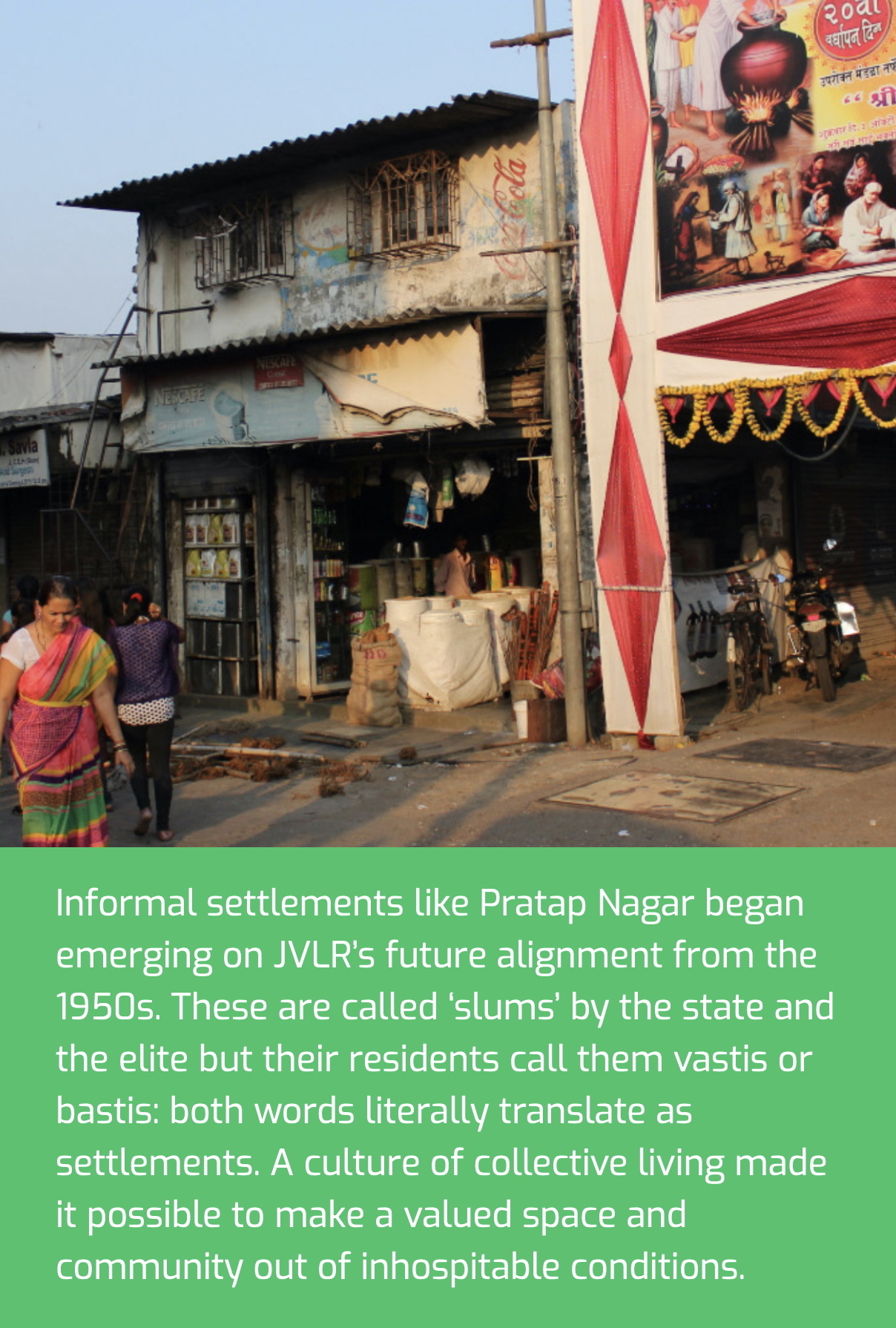
But it is narratives that drive the series of place-based stories that is Makebreak. The narrative form brings to life histories, stories and experiences, which make up individual and collective lived experience. Narrative matters in another way too: it counters the impersonal claim to objectivity and authority that marks expert and policy statements that legitimise violent urban transformation. Narratives humanise every argument by putting viewers through the bath of lived experience at a remove. Who knows, it may even prompt an effort to reconfigure the dominant policy mindset in favour of less violent approaches.
Such a rethinking is long overdue. We believe that the story Makebreak tells is, regrettably, the story of many other cities in India and the global south. The questions it raises bear on our common lives across cities, our ideas about the kind of cities we want to live in, and how we hold our states and decision makers to account for what happens to lives lost and dreams extinguished.
(Makebreak was designed by Design Orb and the site developed by Redstart)
Himanshu Burte, an architect and urbanist, is faculty at Centre for Urban Science and Engineering, Indian Institute of Technology Bombay. Amita Bhide teaches subjects linked to land, housing and urban governance at Centre for Urban Policy and Governance, Tata Institute of Social Sciences (TISS), Mumbai. She also directs the action research project viz: Transforming M ward project. Lalitha Kamath is an urbanist who teaches at the Centre for Urban Policy and Governance, TISS, Mumbai. Ratoola Kundu teaches subjects linked to urban planning and urban transport at the Centre for Urban Policy and Governance, TISS, Mumbai.

